THIS STORY IS ALL ABOUT GRATITUDE. Well, then again, it’s also about curiosity and vision. And learning and teaching about the awesome stuff that happens in the aftermath of Earth-forming fire-and-ice explosions.
It’s also about Mars, the Moon, asteroids, scientific communities, international partners, boundless opportunities… Where to begin?!
 Let’s begin with our star subject, alumna Erica Massey (MSc ’17, BSc ’14), who’s now working in a variety of disciplines first afforded to her as an Earth and Environmental Sciences undergrad in UBC Okanagan’s Irving K. Barber School of Arts and Sciences.
Let’s begin with our star subject, alumna Erica Massey (MSc ’17, BSc ’14), who’s now working in a variety of disciplines first afforded to her as an Earth and Environmental Sciences undergrad in UBC Okanagan’s Irving K. Barber School of Arts and Sciences.
Massey is active as a contract geoscientist with an international firm’s BC satellite offices. The work focuses on mineral exploration and mining projects in the province and abroad, including locations in Arizona, Mexico and the Czech Republic.
“My work challenges me to continue learning and contributing to understanding Earth’s environments,” Massey says. “And possibly other planetary environments.”
“The journey continues. Planetary science calls. Again.”
She’s also priming her UBCO master’s thesis about geological materials and alteration processes resulting from glaciovolcanism (volcanism under glaciers) for a science journal; teaching local elementary school kids about geology and mineralogy; and exploring her own ideas for a PhD research topic in terrestrial and planetary subjects.
Recently, an editor of a planetary science journal invited her to peer review a manuscript that’s “written by none other than the NASA scientist who first reached out to me, who is studying possible subglacial volcanoes on Mars,” Massey says. “I’ve agreed to do so, humbly. I’m so honoured.”
The manuscript is co-authored by planetary geologists, including at least one scientist involved in Mars 2020, NASA’s planned rover mission on the Red Planet.
“So, the journey continues,” Massey says. “Planetary science calls. Again.”
Massey grew up in rural Saskatchewan. She remembers always being outside, running around, living out a farm-girl-next-door zeal for exploring terrestrial oddities. For trying new things and getting her hands dirty.
Her family then moved their large grain operation to Ponoka in central Alberta. “It was a good way to grow up in wide open spaces where I could hear coyotes at night,” she says, adding the rarest and faintest of humble-brags: “I know how to run a combine at harvest time!”
Within 20 years, Massey would be transplanted to Lake Country, BC, just down the road from UBC Okanagan’s campus in Kelowna.
Finding herself a single mother of three school-aged children, Massey didn’t choose the easiest or most obvious path. She chose higher education, and it would make her the first on both sides of her family to attend university, and the first to earn multiple degrees.
“UBC Okanagan’s entire campus made me feel supported throughout the whole process.”
During her undergrad studies, she was awarded the opportunity to attend the University of Iceland in Reykjavík through UBC’s Go Global exchange and study-abroad program, taking her three kids (then in Grades 3, 9 and 10) along on an adventure of a lifetime.
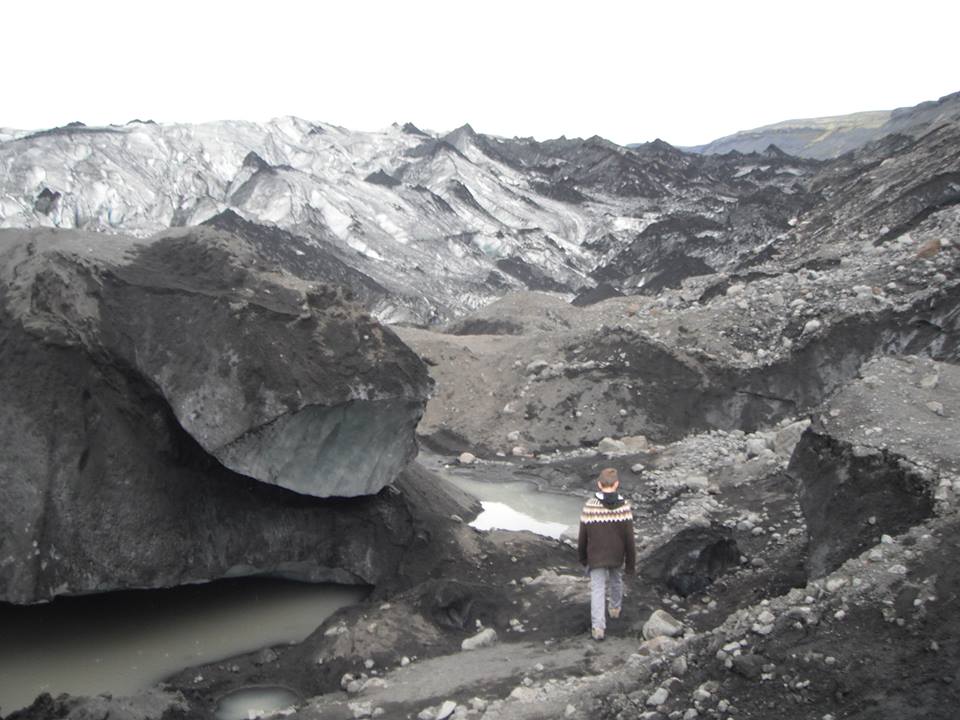
Massey’s adventurous son hiking the Sólheimajökull glacier, S Iceland.
“Being able to share with my kids something bigger than ourselves, and working hard at something worthwhile has made me appreciate opportunities,” says Massey, who counts hands-on learning and extensive fieldwork—climbing into earthquake faults and onto volcanoes and glaciers in remote locations—among her UBC highlights.
“I learned that we’re always taken care of. It’s okay to go to another country and just do something out of the ordinary. And we did it together, going through this special experience—going somewhere different, and with very little—and making the best of it.
“UBC Okanagan’s entire campus made me feel supported throughout the whole process.”
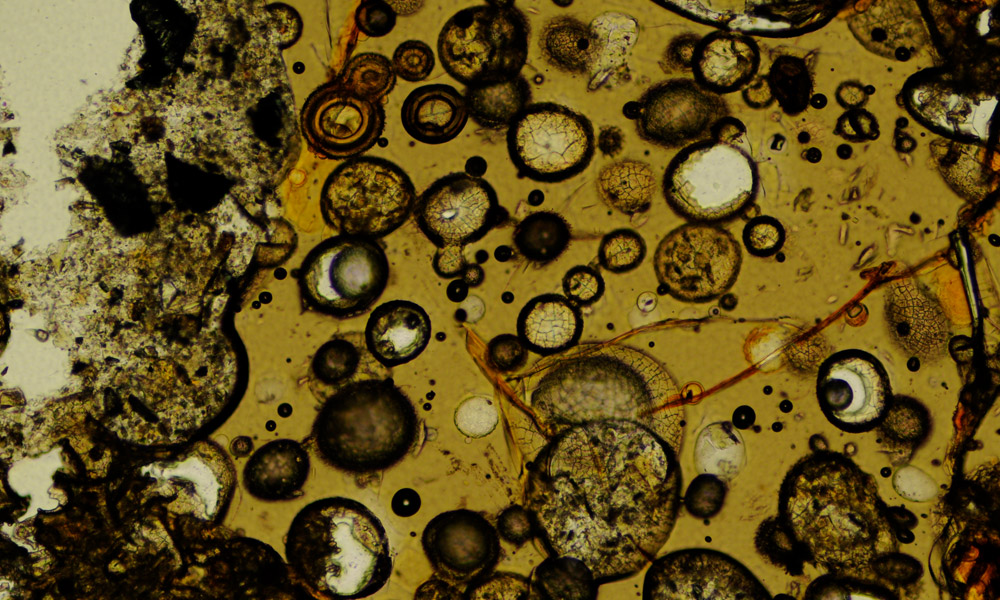
This photomicrograph by optical microscope shows palagonite rims vesicles, grain edges and fractures from a sample Massey collected from Helgafell (“Holy Mountain”) in Iceland.
During her graduate studies, an Earth and Space Science Fellow from the National Aeronautics and Space Administration (NASA) reached out to Massey to discuss her MSc thesis and fieldwork in Wells Gray, BC, and overseas in Iceland.
Iceland is a hotbed of geological activity—a living lab of earthquakes, geysers, glaciers, volcanoes and magnificent molten eruptions from the sea floor, deep under the Earth’s crust. Its oldest rocks were formed about 16 million years ago, but new land is constantly being created in the inexorable convergence of fire and ice.
Massey’s specialized research focuses on glaciovolcanic geochemistry. Simply put, that involves ancient volcanic eruptions that occur beneath mountainous depths of ice and meltwater. Massey looks at the geochemistry and textures of physical remnants in the aftermath of these Earth-forming fire-and-ice explosions.
About 1,600 km from the current southern ice cap of Mars are landscapes with similar compositions and shapes to glaciovolcanoes on Earth, so clues to ancient volcanoes that erupted under glaciers on Mars are important to study here on our own planet.
The substance Massey chose to focus her thesis on is palagonite, which is geological material formed from volcanic (molten) glass in the interaction of lava and water. The Canadian Space Agency considers palagonite material comparable to Martian soil and rocks.
Palagonitization (conversion of glass to alteration materials) has been integral to synthetic glass studies for use in the nuclear energy industry. Radioactive waste is stored in synthetic glass, which is chemically made to last as long as possible.
Observing the deposits on Mars—with new evidence from NASA’s Mars Reconnaissance Orbiter with its mineral-mapping spectrometer, in addition to the robotic space lab Curiosity rover, on the ground since August 6, 2012—may indicate an environment that had life-supporting heat and surface water.
Massey’s rocket-ride into the NASA conversation owes largely to her voracious curiosity about our planet, the universe and deep time. Now she finds herself “breathless” by the reception to her hard-won research accomplishments, and grateful for the doors UBC opened.
“In Iceland, my professors truly taught and mentored us from morning to night how to think and act like scientists—to sit in the environment and use critical thinking to interpret the processes.
“It’s quite surreal to go from just being curious about palagonite—this orange-brown-coloured tuff of rock, kind of like the pictures you see of Mars—that I saw at the outlet glacier of the ice cap that rests on top of Katla, one of Iceland’s most feared volcanoes… to this.”
This is now. “And there are just so many options for the future that are unknown and exciting.”
During her MSc studies, Massey used the Three Minute Thesis (3MT) academic competition to express her curiosity about palagonite and the implications of her findings. She wanted to go back to Iceland. UBC’s International Education Travel Subsidy—plus, a prestigious, merit-based federal NSERC award (a “lifesaver!”)—allowed her to do just that: Go terrestrial; think extraterrestrial.
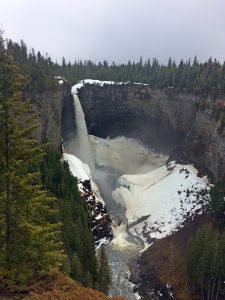
Helmcken Falls in Wells Gray, BC. Photo courtesy Erica Massey
“Thankfully,” Massey says, “professor John Greenough agreed to supervise me on campus and guide me through the whole process. It was important to have the academic and professional support of a supervisor knowledgeable in mineralogy and petrology.”
Along with her UBC prof in Earth and Environmental Sciences (EESC), Massey found a co-supervisor in UBC alumnus Ben Edwards, co-author of Glaciovolcanism on Earth and Mars (Cambridge University Press, 2016).
“Ben’s name kept coming up,” says Massey about the Professor of Earth Sciences at Dickinson College, Pennsylvania. “He’s one of the world’s foremost experts on glaciovolcanism.”
Edwards helped Massey formulate a plan to compare glaciovolcanism in Iceland to the volcanic field of Wells Gray, BC, 120 km north of Kamloops, which was once buried under an estimated 2 km of ice.
Massey and fellow grad students recently formed the GEESC (Graduates in Earth and Environmental Science society), which plans to make a field trip to Wells Gray an annual tradition—cabins, campfires, hikes and waterfalls in what is called the “Valley of Fire and Ice.”
“Grad students tend to work a lot on their own,” she says. “Community means a lot.”
Iceland, about the size of the US state of Ohio, is an island at tectonic ground zero. More than half of Iceland’s glaciers sit near or directly on active volcanoes.
It floats on a core of molten rock fed by the divergent tectonic plates of the Mid-Atlantic Ridge system, which produces enormous volcanic eruptions. The massive, mysterious underwater mountain range is almost as unknown to scientists as the surface of Mars, Venus or the dark side of the Moon.
“I feel most alive when I’m beside volcanoes and glaciers,” Massey says. “Iceland is the most ‘alive’ place I’ve ever been.”
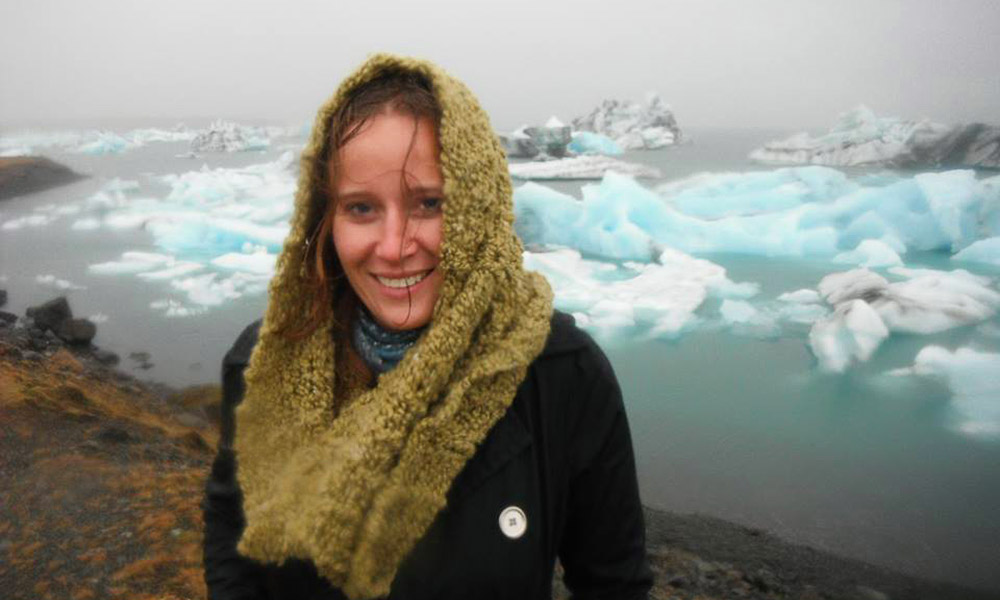
Along the coast in SW Iceland near Jökulsárlón, which translates to “glacial river lagoon”.
The material she studies has been produced through eruptions. Because there’s such a difference in temperature, the hot magma and cold ice/meltwater instantly makes glass. Other rocks and minerals take time to form. “But when magma erupts into water there’s no time to form minerals. It forms glass that has no crystal structure.”
“I feel most alive when I’m beside volcanoes and glaciers.”
Under the microscopes in UBC Okanagan’s Charles Fipke Centre for Trace Element Research, Massey looked at the alteration materials being formed from shards of volcanic glass. Surrounding each glass grain is something called a palagonite rim—it is water-quenched and over time completely converted to minerals like clays and zeolites, she explains. The palagonite cements the whole volcanic pile into a rock-hard substance. These materials and minerals are a signature “clue” for similar deposits on Mars.
Using the latest analytical technology—such as the Scanning Electron Microscope, Laser Ablation, Electron Microprobe and optical mineralogy lab equipment—Massey finds “fascinating and beautiful crystallography and mineralogy, which look really cool, like kinda out of this world.”
Combining methodologies—such as NASA’s use of spectral imaging with Massey’s specialized geoscience—could very well inform what the Mars Society calls “the greatest cause of our generation.”
Massey completed her thesis in the Spring of 2017. It shows geochemical-textural relationships in glass and palagonite that were never before published—different patterns, lines and spheres, some almost vein-like. Other researchers have seen textures that indicate microbial organisms that “eat” (break down) the glass.
“In the lab, I’ve been able to traverse the glass and palagonite at the scale of 1 micron (1/1000th of 1mm) that shows how the chemistry is changing—which hasn’t been shown before quite like this, not at least how I’m going to do it. Finding clues, y’know?”
Geoscientist Sherlocks like Massey are constantly discovering new clues. For example, she recently met a researcher who had moon samples from Apollo space missions. His published research shows that volatiles such as H2O in glass indicate that water exists within the moon, previously thought to be anhydrous.
“Volcanic glass continues to be an important study,” she says, “and I’m glad to continue to learn more.”
Massey’s second foray to Iceland “really opened my mind.” It was spent with University of Iceland researchers on the subject of Surtsey volcano. The small oceanic island grew from the seafloor during basaltic eruptions from 1963-67 about 32 km from the country’s south coast.
Surtsey is a UNESCO World Heritage site protected since its birth for scientific research in geological and biological processes.
One of the scientists on the Surtsey drilling project is studying the DNA sequences of microbial life in the palagonitized samples. Having seen the drill-core images, Massey says, “I have a feeling this will be big for science.”
In the field campaign, Massey was part of a small group of scientists that set up and ran 24-hour shifts in the core processing lab on Heimaey island (“Home Island”), nearly destroyed in 1973 by volcanic eruptions.
Abundant in the rock, microbial organisms are analyzed for DNA. The rock is comprised of basaltic glass and the process of palagonitization that converts the glass to palagonite and alteration minerals—the topic of Massey’s MSc research—is occurring due to water-magma interaction.
“Seafloor volcanism and glaciovolcanism similarly produce volcanic glass that is important in order to interpret environments on and within the continental and oceanic Earth, Mars and even the Moon,” she says.
In August of 2017, with her MSc from UBC, Massey joined a group of international scientists in an expedition that drilled into the island of Surtsey to explore one of the most pristine environments on Earth. It resulted in more than 650 metres of drill-core samples for researchers to study the interaction of cold seawater and hot magma, and to investigate island forming processes, hydrothermal alteration, and the resulting minerals and subterranean microbes that colonize the rock.
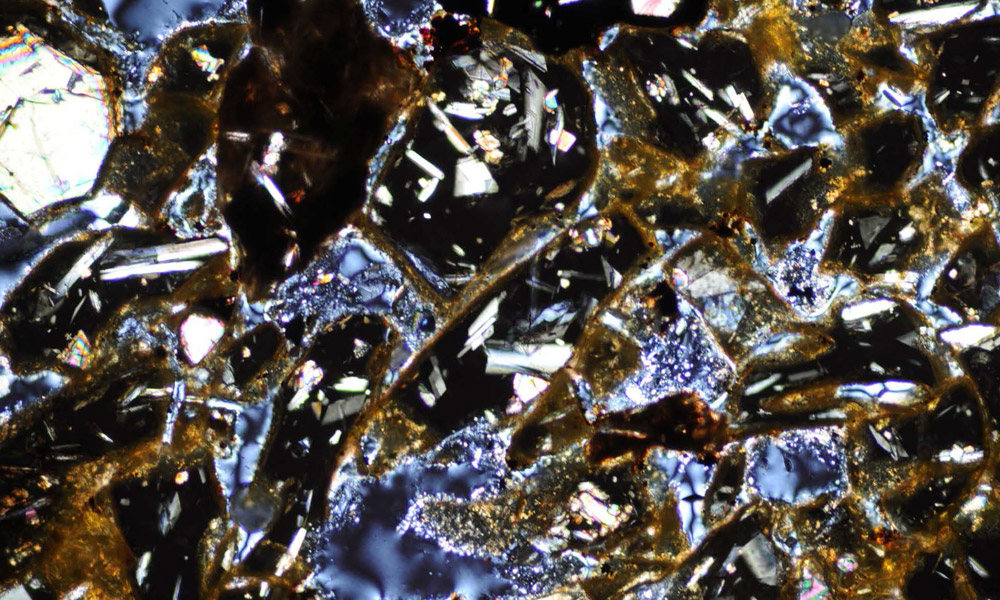
This photomicrograph by optical microscope shows basaltic glass grains with microlites of plagioclase and olivine minerals, sourced from Wells Gray volcanic field, interior BC. Plagioclase is abundant on the Moon and Mars.
Theories exist that say an ocean of ice lives under the surface of Mars, and that, if terraformed, the Red Planet could be habitable by humans as early as this century.
Massey is a member of the Mars Society, a worldwide advocacy group that considers the exploration and settlement of the Red Planet as “one of the most daring and audacious human endeavours of our time.”
She has daring and audacity in spades—plus, Massey’s membership in the Mars Society puts her in good research company, among the likes of SpaceX and Tesla founder Elon Musk, arguably the world’s most-influential cheerleader for planetary exploration.
Musk is a modern-day explorer who’s predicting a Martian landing in about 10 years. Meanwhile, NASA’s forecasting a safe mission in the 2030s.
Whatever the horizon goal actually is—and given China and Russia’s technological advancements—the race to Mars is very much on.
Some think that in the ancient Earth, with all the volcanism and water, early life could have happened in those extreme environments. Massey claims to have found textures similar to ones in those studies, which links into Mars research, too.
Heat + moisture = microbial life. Or does it?
“Scientists are really interested in finding some form of life—it’s like a new frontier,” she says. “I want to believe. Actually, I do believe.”
“I am forever grateful for those moments where my professors and mentors really took the time to teach outside where it all happens, and to inspire us to think like scientists.”
“My perspective is so broad now! I’ve learned about the Universe, the Earth, the planet’s core. Nature follows certain laws.”
“Before, I felt like I was just living. I didn’t understand how nature works, didn’t look at mountains and think about why or how they exist. Now I understand my surroundings.”
Being outside, in the environment, catalyzed Massey’s academic and career momentum.
“I am forever grateful for those moments where my professors and mentors really took the time to teach outside where it all happens, and to inspire us to think like scientists.”
On “one of the most momentous occasions” of her life, Massey and Edwards, on the perfect chance, were in Iceland at the same time. Together they walked the entire ridge of Helgafell—Icelandic for “Holy Mountain”—where the ocean floor rises up to become part of the island. The tectonic plates are separating, and geological and geothermal activity abounds.
“Trying to figure out what we are looking at is like a mix of detective work, chess, and thinking really, really big outside of the box, while mixing in chemistry, physics and geology,” Massey says.
The panoramic view from the top of Helgafell overlooks lava fields that go for miles without a plant or tree in sight.
“For some reason it is utterly beautiful and stunning. We talked about the most amazing things related to geoscience. It felt like Ben taught me about 20 geology classes in our one hike.”
So there was Massey and Edwards at Helgafell, both UBC alums, nerds for science, together, side by side by side with an international crew of fellow curiosity rovers, all decidedly not alone in the universe.
Looking out over the great expanse from the top of a holy mountain, they watched the birth of new lands and worlds in their becoming.
It was one heck of a field trip.








